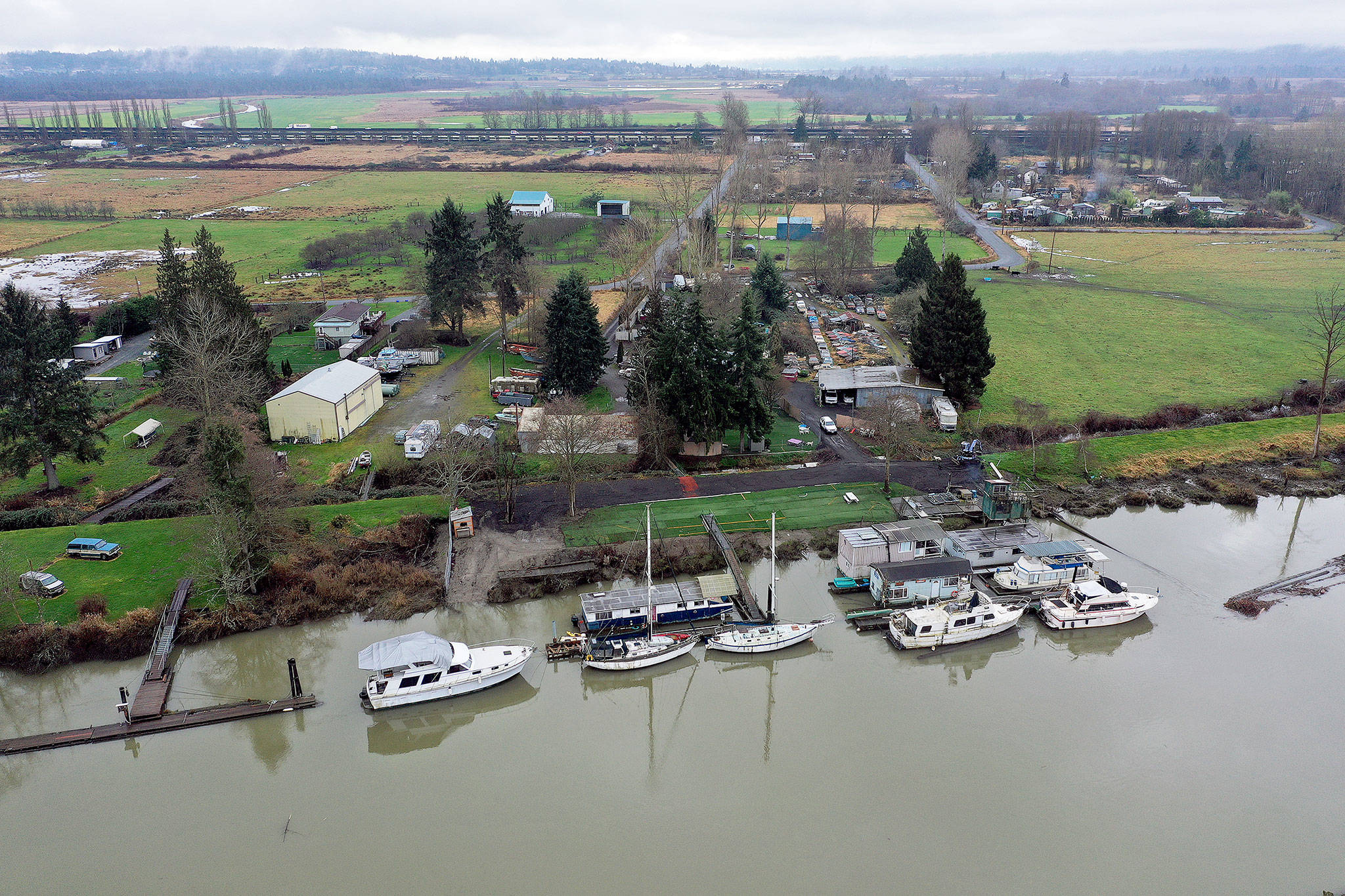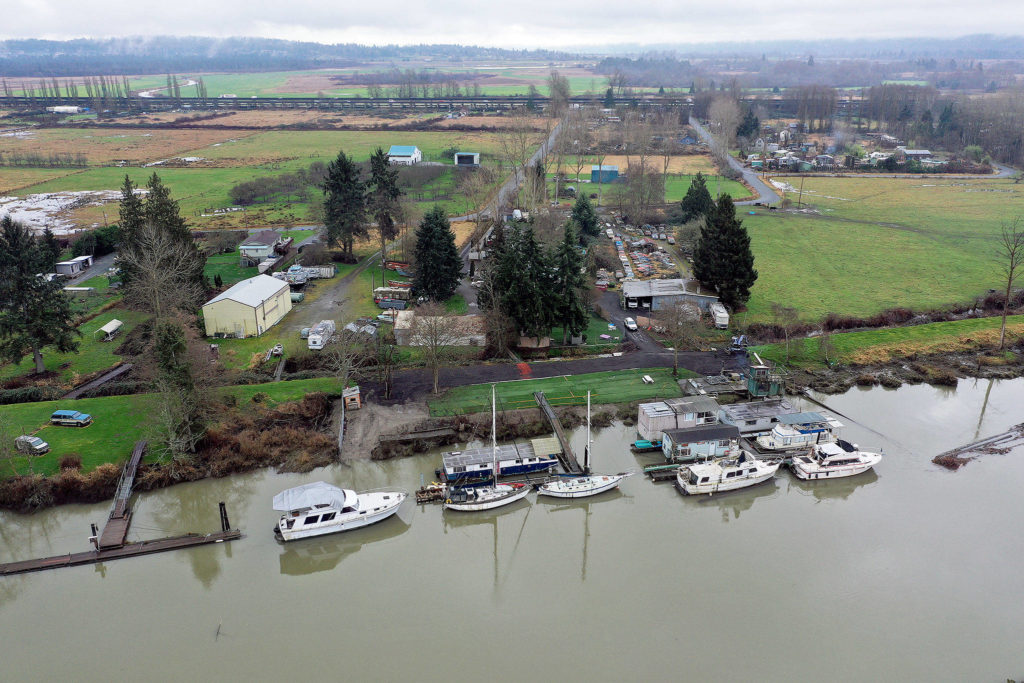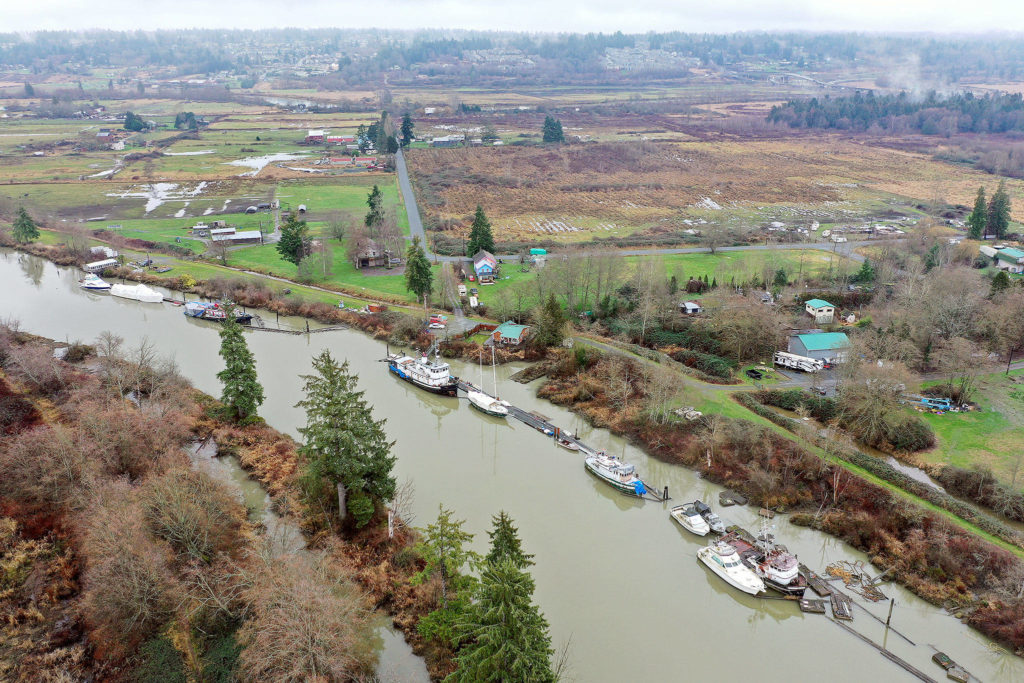EVERETT — They sit in hidden places.
Like tucked away north of the U.S. 2 trestle, down a gravel road, behind a locked gate on a property that resembles a junkyard. Signs along the barriers warn “No Trespassing” and “Beware of Dog.”
There, illegally stored houseboats, tugs and bayliners float — and sometimes sink, causing headaches for state and local agencies charged with protecting marine life and restoring salmon habitat.
Of the dozen or so such marinas identified by the state Department of Natural Resources in recent years, about half were on the Snohomish River, where out-of-the-way estuaries and aging docks provide the ideal camouflage for such operations, department officials say.
In the past five to 10 years, DNR has stepped in to guide dock owners toward compliance with the law, cutting the number of illegal marinas on the Snohomish from six to two, with the remaining pair working toward compliance. The rest were scattered in places like Grays Harbor, Lake Washington and the Columbia River.
“It’s a testimony to our relationship,” said Ben Cooksey, a land manager for the department. “We’re not out to be punitive. We view ourselves as the back yard neighbors that want to have a good relationship. Voluntary long-term compliance is always the goal.”
Not all of the boats are beyond repair. Some are in good shape and still run. But rivers are no place to store a boat, Cooksey said.
Last year alone, the department’s Derelict Vessels Removal Program spent more than $500,000 to remove three sunken boats from the Snohomish, including one that had been stored at an illegal marina.
“Boats are incredibly expensive to keep maintained and will fall apart fast,” he said. “These aren’t floating houses. They’re barges with stick frames on them.”
The ‘Redneck Yacht Club’
Under state law, waterfront property owners can build recreational docks to moor up to four boats. The law also requires the dock meet county codes. But it prohibits houseboats and commercial activity, like renting out spaces.
On the Snohomish, those laws often are ignored.
Records from the Snohomish County Assessor’s Office led to more than 20 phone numbers associated with illegal marina owners. All but one was disconnected.
Along the riverfront, few people were willing to speak with a reporter, and fewer were willing to give their names and talk on the record. If there’s one thing folks living here don’t want, it’s publicity. Many of the docks on the Snohomish have been around for decades. Half were built in the ’50s, ’60s and ’70s, Cooksey said.
One dock owner calls his illegal marina the “Redneck Yacht Club,” Cooksey said.
“Out of the goodness of his heart, he lets people dock there, and 90% of these boats haven’t been used and aren’t in running condition,” he said.
A neighbor who would not give his name compared the area along the river to the Old West, a part of the county rarely visited by law enforcement or elected leaders.
A woman who owns land near Spencer Island said she reluctantly inherited the property and its dock five years ago from her parents.
Since then, she has reduced the number of moored boats from nearly 20 to about 10.
Still, DNR has made it difficult, she said.
“No matter what we do, they just come around and ask for more,” she said.
She doesn’t live on the Everett property and doesn’t know how many boats are now at the dock, she said.
How a vessel ends up at an illegal marina is another story.
In one case, an elderly dock owner was out of state receiving medical treatment. With no caretaker watching the property, boats began to anchor without permission, like squatters.
In other cases, people find a free or cheap boat on Craigslist. The new boat owner usually has lofty goals of restoring the rundown vessel to its former glory, but needs somewhere cheap to store it while trying to scrape together enough cash to get it running again.
And that day seldom comes.
Meanwhile, private docks offer cheap, but illegal, mooring fees.
To avoid being identified, owners sometimes scrub boat registration numbers or paint over them. In other instances, owners list places like the Seattle Food Bank as their address. In those cases, DNR will reach out to local authorities and ask, “If you find this person, would you let them know their boat is sinking?”
For others, an old houseboat on the river is a cheap place to live away from the city.
Cooksey estimated about 10 people live at illegal marinas on the river. Most are experiencing some form of homelessness.
“You have to be creative to live,” he said. “It can be very romantic to live on the water. But the honeymoon is usually over after two weeks to 30 days.”
A hefty fine
When Cooksey goes out to illegal marinas, most of the time no one’s home, he said.
The first two years of outreach are about educating the dock owners on state law and how they can comply. After that it’s more like, “Hey, we really need to do this.”
To make that point, the DNR fines illegal marina owners 150% of what local ports charge for mooring fees. In Everett, four dock owners avoided the fees by quickly moving toward compliance.
Two dock owners decided instead to pay the hundreds of dollars each month.
Yet the financial burden can fall onto the people storing their boats, if marina landlords opt to impose mooring fees.
“None of them have admitted to charging fees,” Cooksey said. “They figure it as an informal relationship where people help pay utilities and things like that. We know they’re receiving money.”
Cooksey doesn’t want dock owners passing along the fees, but “enforcing the law is a necessary evil,” he said.
DNR isn’t alone in combating derelict vessels in the Snohomish.
The Snohomish County Marine Resources Committee, a volunteer board with 12 members, helps arrange the removals, in addition to other work to maintain local waters.
The MRC works with staff from the county’s Surface Water Management Department.
In 2018, the group helped with five boat removal projects. Last year, the number was two.
“Very few other counties are actually doing that,” Cooksey said.
For one thing, it’s expensive.
The Midas, a WWII-era 100-foot abandoned commercial fishing vessel, sat in the river more than a year before a crane and barge broke it into pieces and hauled it away in September.
Weeks later, crews removed a 50-foot homemade sailboat half a mile from the Midas after it spilled oil.
Before those projects, a houseboat connected to one of the marinas drifted down the river, falling apart and leaving debris in the water.
On Friday, another boat used in WWII appeared near in local waters. The Argosy, built in 1925, washed ashored on Mission Beach in Tulalip.
DNR had been monitoring the vessel for years, but doesn’t have jurisdiction because it’s on the Tulalip Indian Reservation.
When DNR removes a boat, the vessel owner is responsible for covering the costs.
Of the millions of dollars the department spends on derelict vessels, less than 0.5% of costs are recovered by the state. The DNR program’s biennial budget is usually depleted after the first year. In 2019, DNR went to the Legislature to ask for money, citing the Midas as one of the projects that can eat up the program’s two-year budget.
To avoid the costly projects, DNR and the Marine Resources Committee ask owners of old boats to get proactive.
Vessel turn-in programs at the state and local level take care of boats at risk of sinking, for a fraction of the cost of a DNR removal.
“That’s our way of trying to mitigate having boats dropped off in the first place,” MRC planner Elisa Dawson said.
The MRC also developed a statewide app called MyCoast that lets residents report derelict boats in local waters.
A hefty cost
Marinas and boats aren’t the only inhabitants of the Snohomish River.
Channels and estuaries play a key role in the state’s plan to boost the salmon population.
Juvenile salmon are about the size of an index finger. They can spend weeks growing in estuaries before heading to Puget Sound. But illegal marinas and derelict boats, along with other man-made obstacles, have played a role in damaging the critical dwelling spaces.
“In the Puget Sound, we’ve seen the death to salmon habitat by a thousand cuts,” Cookesy said.
Boats cut loose from the marinas or abandoned in estuaries often run aground on riverbanks, in the vegetation where juvenile salmon are supposed to be able to hide from predators, said Lindsey Desmul, a habitat biologist for the state Department of Fish and Wildlife.
Those who live at the illegal marinas often pollute the river with trash and human waste.
The biggest threat from boats is what’s in the gas tank, said Andrew Quast with the state Department of Ecology. Different fuels have different effects on waters, but they’re all harmful, Quast said.
Eleven ounces of motor oil will cover about 11,000 square feet of water, said state Department of Ecology spokesperson Larry Altose.
“Sometimes the sheen is so thin” — like in the sailboat spill — “we don’t have a means to get it off the water,” Quast said.
The state arranges oil spill cleanups on the river two to three times a year, he said. But some weather conditions can leave a spill unnoticed, and when it comes to human waste, there’s little the agency can do.
The state Fish and Wildlife Department has nearly 40 estuary and salmon habitat restoration projects planned for 2019 to 2021, but there’s still much left to be done, Desmul said.
Estuaries are just one piece of the puzzle. Restoring habitat upriver and in the ocean can be equally critical, she said.
“The salmon recovery world is just impossibly complicated,” she said.
The river and its estuaries have faced pollutants since Everett was founded, Desmul said. The old pulp mill pumped waste into the waters. Expanding city limits disconnected channels critical for salmon.
“It is a little disheartening to see derelict vessels still show up in these waterways when we have spent so much time to restore this habitat for juvenile salmon,” she said. “You can’t blame them for wanting to be there.”
Joey Thompson: 425-339-3449; jthompson@heraldnet.com. Twitter: @byjoeythompson.
Talk to us
> Give us your news tips.
> Send us a letter to the editor.
> More Herald contact information.



























